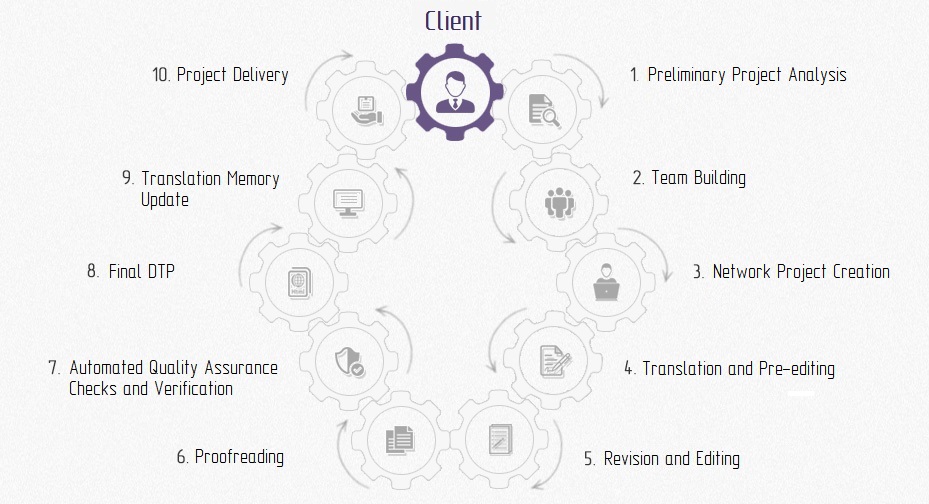-
1
Preliminary project analysis: first and foremost, we assess the translation subject, then analyze its volume and complexity. We also take into account the customer's existing translation memory database, experience in the area under consideration, the potential availability of translators and much more. The key objective at this stage is to assess the required resource and send a quote to the client with allowance for deadlines.
-
2
Team building: depending on volumes and deadlines, we evaluate the required number of translators and editors. Some safety margins and potential personnel reserve are taken into account. If necessary, we engage experts in narrow fields who are not translators but may provide useful information in this sphere as consultants.
-
3
Creating a network project: We use cutting edge innovations, such as Translation Memory, which provide simultaneous access to translation for all participants, including translators, editors and quality assurance specialists. A network project includes the existing databases from previous projects for this customer, glossaries, adjusted segmentation rules, etc.
-
4
Translation and preliminary editing: When the translation team begins its work, the editor doesn't sit idle. They monitor the process, coordinating the translation and ensuring terminology consistency. This feature of our translation process allows for faster editing when translation is finished. By this time, the editor will know the subject matter, and the translators will have taken into account his or her comments.
-
5
Editing: We engage specialists in the corresponding fields as editors. In addition, we do not hesitate to work extensively with the customer: after all, it is the customer who can provide valuable information on translation of certain terms and clarify the meaning of certain fragments. This is the key to high-quality translation. Our texts are natural and clear to specialists in the corresponding fields.
-
6
Proofreading: If agreed, the text is proofread by another linguist. The main task here is to correct any stylistic and grammatical errors. In this case, the proofreader does not check against the source text and works only with the target. However, if something seems strange or dubious, he or she will be sure to inform the editor and the project manager.
-
7
Automated quality assurance: Modern software allows for automatic detection of many mistakes. This is a great help to editors and proofreaders. These errors include, for example, incorrect localization of numbers, double spaces, sentences without translation, etc. Though complementary, this type of quality assurance is very important since a single wrong digit can make a technical text completely useless.
-
8
Final translation layout: We offer final DTP service which includes adjustment of translation formatting. Separate text blocks, lettering and tables are arranged exactly in the same way as in the source text.
-
9
Translation memory update: We want our customers to become our regular clients. This is why we store all valuable information gained while working with them. This refers not only to translation memories, but also glossaries and even individual style guides that we develop together with our customers. At any time when you contact us again, we can quickly get started from the place where we left off. You won't have to waste time getting us up to speed and repeating your instructions, and the translation will be in full conformity with previous texts.
-
10
Project delivery: The result is a product of an elaborate process, which is why we don't have quality problems. In any case, we are always happy to consider any wishes of the client because we work for you.






